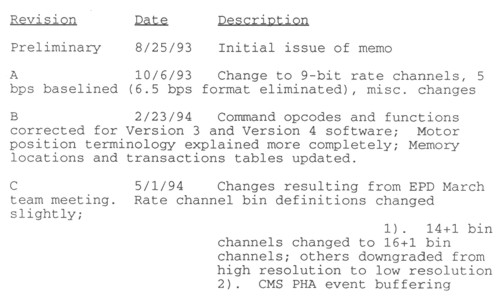The Galileo Energetic Particles Detector
Galileo EPD Handbook
Chapter 2. EPD Software
EPD SBAND Mission Software Requirements
Source: S. Jaskulek, various dates
Note: This material is based on 2 versions of the SBAND document--Revision H, Software Version 2, and a set of pages to update the document from H to I and referencing Software Version 3.
Contents
- Introduction
- Software Versions
- Science Background
- EPD Telemetry Output Rates
- EPD Rate Channel Data Processing
- Telemetry Output Buffers in the EPD Memory
- CDS Rate Channel to Bin Algorithm
- Rate Channel Array Compression
- CMS Pulse Height Analysis (PHA) Data
- CDS-EPD Interface Description
- CDS-Produced EPD Telemetry Record
- New EPD Software Tasks
- Telemetry Mode Change
- Motor Control Functions
- New EPD Command Functions
- Transition Mode Commands
- EPD Memory Storage Availability
- EPD Memory Map
- Appendix A: Buffer storage for the EPD rate channel bins
- Appendix B: EPD Accumulator Hardware Addresses
- Appendix C: EPD Software Patch Hook Values
- Appendix D: EPD Telemetry Mode Definition Blocks
List of Revisions - Revision H


F
7/31/95 Corrections made following CDS integration tests.
The RTI9 address in the RECORD mode telemetry definition
block was wrong;
it was changed to 1A8F. The HV level command code at address
1B20 was
modified to fix a bug and agree with requirements. A fourth
and fifth transitional
command, 25JKRP (C0) and 25RESC (01) were added to the RT
mode list.
A correction was made to the science record status byte
description (section
11.2.6); the motor direction and position are sampled at the
end of the science
record, not the beginning. Science record
resynchronization requirements (when
scanning is interrupted) are more explicitly described in
section 13.

List of Revisions - Revision I

Next: Introduction
Return to Galileo EPD Handbook Table of Contents Page.
Return to main
Galileo Table of Contents Page.
Return to Fundamental
Technologies Home Page.
Updated 8/23/19, Cameron Crane
QUICK FACTS
Mission Duration: Galileo was planned to have a mission duration of around 8 years, but was kept in operation for 13 years, 11 months, and 3 days, until it was destroyed in a controlled impact with Jupiter on September 21, 2003.
Destination: Galileo's destination was Jupiter and its moons, which it orbitted for 7 years, 9 months, and 13 days.



